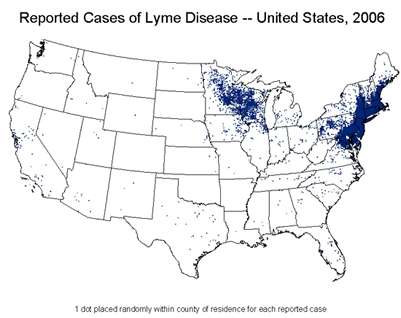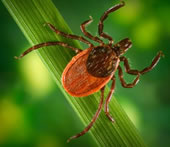| |
|
| Images courtesy of CDC Public Health Image Library |
Overview
Lyme disease is the most commonly reported tick-borne disease in the
United States. In 2005, more than 23,000 cases of Lyme disease were reported
to the Centers for Disease Control and Prevention (CDC). Lyme disease
is passed to humans by the bite of black-legged ticks (also known as
deer ticks in the eastern United States) and western black-legged ticks
infected with the bacterium Borrelia burgdorferi. The Lyme disease bacterium
normally lives in mice, squirrels, and other small mammals.
Outdoor workers are at risk of Lyme disease if they work at sites with
infected ticks. U.S. workers in the
northeastern and north-central States are at highest risk of exposure to infected
ticks (see map of U.S. cases of Lyme disease reported in 2005 below). Ticks may also transmit other tick-borne diseases to workers in these and other regions of the country. Worksites
with woods, bushes, high grass, or leaf litter are likely to have more
ticks. Outdoor workers should be extra careful to protect themselves
in the late spring and summer when young ticks are most active.
 |
Image courtesy of CDC Division of Vector-Borne
Infectious Diseases
|
Occupations at Risk
All outdoor workers should check with their supervisor if they have questions about possible exposure to Lyme disease. Workers at risk of Lyme disease include, but are not limited to, those working in the following:
- Construction
- Landscaping
- Forestry
- Brush clearing
- Land surveying
- Farming
- Railroad work
- Oil field work
- Utility line work
- Park or wildlife management
- Other outdoor work
Recommendations for Employers
Employers should protect their workers from Lyme disease by taking these steps:
- Provide training for workers that includes information
about the following:
- How Lyme disease is spread
- The risks of exposure and infection
- How workers can protect themselves from ticks
- The importance of the timely reporting of workplace
illnesses and injuries
- Recommend that workers wear light-colored long-sleeved shirts, long
pants, socks, and hat when possible.
- If worker uniforms are provided, provide long-sleeved
shirts and long pants as options.
- Provide workers with repellents (containing 20% to 30% DEET) to use on their skin and clothing for protection against tick bites.
- Provide workers with insecticides (such as permethrin)to provide greater protection. Permethrin kills ticks and can be used on clothing (but not skin).
- When possible, have workers avoid working at sites with woods, bushes,
tall grass, and leaf litter.
- When avoiding these sites is not possible, personal protective measures are of particular importance. If work in these higher-risk sites must occur,
take the following steps to reduce tick populations:
- Remove leaf litter.
- Remove, mow, or cut back tall grass
and brush.
- Control rodent and small mammal populations.
- Discourage deer activity.
|
| Images courtesy of CDC Public Health
Image Library, CDC Division of Viral and Rickettsial Diseases
and the CDC Division of Vector-Borne Infectious Diseases |
Recommendations for Workers
Take the following steps to protect yourself from tick bites:
- Wear a hat and light-colored clothing, including long-sleeved shirts and
long pants tucked into boots or socks.
- Use insect repellents that provide protection for the amount of
time you will be outdoors:
- Follow repellent label directions for use.
- Use repellents containing 20% to 30% DEET on your skin or clothing.
- Reapply repellents as needed.
- Use insecticides such as Permethrin for greater protection.
- Permethrin kills ticks on contact.
- Permethrin can be used on clothing but should not be used on skin.
- One application of permethrin to pants, socks, and shoes typically stays effective through several washings.
- Check your skin and clothes for ticks every day. The immature forms of these ticks are very small and may be hard to see.
- Remember to check your hair, underarms, and groin for ticks.
- Immediately remove ticks from your body using fine-tipped tweezers.
- Grasp the tick firmly and as close to your skin as possible.
- Pull the tick's body away from your skin with a steady motion.
- Clean the area with soap and water.
- Removing infected ticks within 24 hours reduces your risk of being infected with the Lyme disease bacterium.
- Wash and dry work clothes in a hot dryer to kill any ticks present.
- Learn the symptoms of Lyme disease.
- If you develop symptoms of Lyme disease seek medical attention promptly. Be
sure to tell your health care provider that you work outdoors in an
area where ticks may be present.
Symptoms of Lyme Disease
Lyme disease may cause one or more of the following symptoms:
- An expanding circular rash called erythema
migrans (may look like a red bulls-eye at the site of the
tick bite)
- Fever
- Joint and muscle pains
- Headache
- Chills
- Fatigue
- Swollen lymph nodes
Any worker who has symptoms consistent with Lyme disease should contact
his or her health care provider.
Diagnosis and Treatment of Lyme Disease
Lyme disease is diagnosed based on symptoms and the possibility that the worker has been exposed to infected ticks.
Most cases can be successfully treated with antibiotics, especially if treatment is started early. However, some workers may have symptoms such as arthritis, muscle and joint pain, or fatigue for an extended period of time.
Prevention and early diagnosis of Lyme disease are important in pregnant workers. Lyme disease acquired during pregnancy may lead to infection of the placenta and possible stillbirth. However, no negative effects on the fetus have been found when the mother receives appropriate antibiotic treatment. There are no reports of Lyme disease transmission from breast milk.
Workplace Resources
Occupational
Safety and Health Administration (OSHA) Lyme Disease Alert Fact Sheet
Identifies regions where outdoor workers are at risk of Lyme disease and provides
prevention methods.
External Link: http://www.osha.gov/OshDoc/data_LymeFacts/lymefac.pdf
OSHA Safety
and Health Information Bulletin: Potential for Occupational Exposure to Lyme
Disease
Provides recommendations for reducing the risk of occupational Lyme disease. Includes
background information, methods for identifying potential tick habitats, steps
for avoiding and controlling the disease, and methods for identifying and treating
an infection.
External Link: http://www.osha.gov/dts/shib/shib021103.html
OSHA
Logging eTool: Tick-borne Disease
Recommends safe work practices to prevent and control Lyme disease. Explains
how to check for and remove ticks.
External Link: http://www.osha.gov/SLTC/etools/logging/mechanical/firstaid/tick_disease.html/
OSHA
Saw Mills eTool: Tick-Borne Illnesses
Addresses the potential risk of Lyme disease and other tick-borne illnesses
in workers with jobs in heavily wooded or grassy areas.
External Link: http://www.osha.gov/SLTC/etools/sawmills/tick_borne.html#Lyme
disease
Center to Protect
Workers' Rights Hazard Alert: Lyme Disease in Construction
Informs construction workers about the risk of working outdoors and being exposed
to ticks infected with Lyme disease. Provides specific precautions for protection
from infection.
External
Link:http://www.cpwr.com/hazpdfs/hazlyme.pdf
En Español
CDC Resources
CDC Lyme Disease Home Page
Provides
comprehensive information about Lyme disease prevention, transmission,
diagnosis, and treatment.
CDC Lyme Disease Prevention and Control
Provides
methods to avoid exposure to ticks and prevent Lyme disease.
CDC Feature: Stop Ticks
Identifies several tick-borne diseases and suggests methods for protecting you and your family from tick bites.
NIOSH Related Publications
Histoplasmosis—Protecting
Workers at Risk
DHHS
(NIOSH) Publication No. 2005-109 (2004)
This revised booklet provides updated information about worker exposure to the
disease-causing fungus Histoplasma capsulatum. It provides information
about histoplasmosis, identifies activities that may put workers at risk, and
recommends methods for preventing disease and protecting workers.
En Español
West Nile Virus: Recommendations for Protecting
Outdoor Workers from Exposure
DHHS (NIOSH) Publication No. 2005-155 (2005)
This document
answers questions relevant to outdoor workers and West Nile virus;
it also contains recommendations for preventing the exposure of outdoor
workers to West Nile virus.
En Español
Working in Hot
Environments
DHHS (NIOSH) Publication No. 86-112 (April 1986, reprinted 1992,
with minor changes)
This publication discusses the safety and health consequences of heat
stress. From iron workers to pastry bakers, Americans work in a wide variety
of hot or hot and humid environments. Being uncomfortable is not the major
problem with working in high temperatures and humidities. Workers who
are suddenly exposed to work in a hot environment face additional and
generally avoidable hazards to their safety and health.
En
Español
Related NIOSH Safety and Health Topics
Tick-borne Diseases Topic Page
Provides information about U.S. tick-borne diseases and recommendations for protecting workers from them.
Agriculture Topic Page
Provides links
to publications and resources on agricultural topics including ergonomics,
grain handling, injuries and deaths, machinery, and young workers.
Avian Influenza Topic Page
Provides information
about avian influenza, identifies potential risks for poultry workers,
and explains the potential threats associated with the virus.
Heat Stress Topic Page
Provides
information about heat-induced occupational illnesses, injuries, and
reduced productivity along with methods for reducing risk.
Protective
Clothing and Ensembles Topic Page
Provides
information about protecting the skin from various health hazards that
may be encountered at work or during a terrorist attack.
West Nile Virus Topic Page
Provides information
about the West Nile virus, identifies workers at risk, and recommends
methods for preventing worker exposure.
Page last updated: October 22, 2008
Page last reviewed: June 20, 2008
Content Source: National Institute for Occupational Safety and Health (NIOSH)
|
 |
Lyme Disease
 |
|

